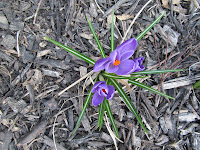My daughter is taking a nap, my husband is watching
football, and I am finally sitting down to write a blog post. It has been over
7 months since I’ve posted anything, and since this time of year tends to inspire
(lofty) goals of positive habits, I’d like to get back into the practice of
writing down some of my musings every
week.
I love making resolutions. In fact, I often make them throughout
the year. Here are some examples: 1. I resolve to write a poem a week. 2. I
resolve to stop leaving my clothes in the dryer. 3. I resolve to brush my
kitties every day. 4. I resolve to quit nagging my husband (as long as he
resolves to quit doing whatever it is that inspires me to nag him). It occurs to me that I enjoy breaking these mundane
resolutions as much as I enjoy making them. I can’t think of one haven’t
broken. I’ve never been one for strict rules but there is a part of me (the
perfectionist part) that wishes I was. We’ll see how long this resolution of a
weekly blog post holds up. (And if I fail to do it weekly, I reserve the right
to resolve to do it biweekly – as long as that means every 2 weeks and not
twice a week).
Lately, I’ve been thinking a lot about time. This
preoccupation with time is something I’ve always had but since I found out I
was pregnant toward the end of 2012 (see?), it suddenly became magnified. I
think this is because, as I’ve mentioned in earlier posts, pregnancy and
infancy are measured in days and months, rather than years. Yesterday, I
listened to a fascinating podcast on time produced by Radiolab: http://www.radiolab.org/story/91584-time/.
I love thinking about how to a whale we humans are flitting around like hummingbirds
(although I imagine a lot less purposefully)and how to hummingbirds we humans
are meandering giants (oh, if only I could figure out how to go slower). Then,
last night, I read this poem, “Theories of Illusion,” by Maureen Seaton, in
which she ends:
My
favorite illusion it the one about the relativity
of
time. How the humpback with her big slow heart,
her
contrapuntal biorhythm, weaves a song in the deep—
half-hour
concert to her, to us a minute waltz.
(You can read it in its entirety in her new book, Fibonacci
Batman, or if you have a Project Muse account.) It’s these types of connections
that make me love science and poetry and the time to take them both in on one
day! Now, I just have to figure out how to create time to do that every day. Or
stretch time. Or slow time down. Or tell time. That reminds me, I need a new planner.






















